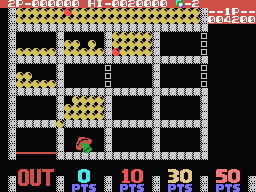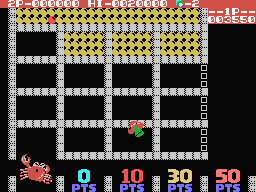Retro Replay Review
Gameplay
Lot Lot’s core mechanic is delightfully straightforward: you guide balls through a grid by swapping filled and empty sections until they tumble into one of five pits. Each pit awards a different point value, ranging from zero to fifty, and every level challenges you to meet a target score before proceeding. The simplicity of pressing the space bar (or fire button) to move balls belies the depth of planning required to chain high‐value drops and avoid costly mistakes.
(HEY YOU!! We hope you enjoy! We try not to run ads. So basically, this is a very expensive hobby running this site. Please consider joining us for updates, forums, and more. Network w/ us to make some cash or friends while retro gaming, and you can win some free retro games for posting. Okay, carry on 👍)
What sets Lot Lot apart is the dual‐arrow system. The lead arrow selects your target section while the trailing arrow follows with a slight delay, creating moments of tension as you time swaps just right. This mechanic forces you to think ahead: if two sections both hold balls, they swap; if one is empty, all balls shift in unison. Each successful drop into the 50‐point pit feels earned, and the risk of misplacing a swap—and potentially sending balls into the dreaded “OUT” zone—keeps you fully engaged.
Levels steadily increase in difficulty by narrowing time limits, raising target scores, or accelerating the pace at which walls vanish. Randomized wall drops ensure no two challenges play out identically, encouraging you to adapt on the fly. The thin red‐lined section in the bottom left adds an extra layer of hazard: any ball that enters summons a crab which severs your line, forcing those balls straight into “OUT” and costing you a life. It’s a clever twist that injects tension without overcomplication.
Despite its simple premise, Lot Lot offers surprising replay value. Players aiming for perfect runs will find themselves replaying early levels to shave off precious seconds or optimize point gains. Between the satisfying click of successful swaps and the sting of a crab‐induced failure, you’ll find plenty of incentive to keep refining your strategy and pushing for higher scores.
Graphics
Graphically, Lot Lot embraces a clean, minimalistic style that perfectly suits its puzzle‐centric gameplay. The grid is rendered in bright, contrasting colors, with each ball sporting a vibrant hue that makes it easy to track shifts and drops. The pits at the bottom are distinctively labeled (0, 10, 30, 50, and OUT) in bold typography, ensuring you always know which drop zone you’re aiming for.
Animations are smooth and responsive. Walls disappear with a subtle fade, and balls roll or fall with believable physics, adding a tactile quality to each action. The red line in the danger zone pulses gently, warning you not to stray—until you do, and the crab’s razor‐clawed appearance is jarringly well‐animated. These small touches give the game a polished feel despite its retro inspiration.
The user interface remains unobtrusive yet informative. A simple score display and level target sit at the top of the screen, updating in real time as you accumulate points. There’s no clutter—just the elements you need to stay focused on the puzzle. Even on smaller displays, icons and text remain legible, with none of the pixelation issues common to indie titles.
While Lot Lot doesn’t aim for photo‐realism, its stylized visuals convey just the right amount of charm and clarity. It’s a testament to how purposeful design choices—clean lines, bold colors, and subtle animations—can elevate a straightforward puzzle game into a visually pleasing experience.
Story
Lot Lot doesn’t weave a grand narrative; instead, it situates you in a gleefully mechanical world of falling orbs and numbered pits. The implicit “story” unfolds through its hazards and objectives: you’re a master manipulator orchestrating gravity’s pull to achieve point‐scoring perfection. While there’s no protagonist with dialogue, each level’s challenge feels like a set piece in an ongoing test of your wits.
The only true antagonist is the mischievous crab guarding the red‐lined pit. Its sudden appearance and claw swipe add a playful, if slightly menacing, flourish to the proceedings. In a way, the crab embodies the game’s spirit: there’s room for creativity and fun, but a single lapse in concentration can lead to a rapid downfall. That tiny narrative element injects personality into an otherwise mechanical affair.
Backgrounds remain static and unobtrusive, reinforcing the focus on ball movement rather than story beats. However, the gradual escalation of targets and hazards tells its own tale of rising stakes. Each new level reveals a fresh puzzle configuration, prompting you to read the “environment” anew and adapt your strategy, much like chapters in an evolving saga.
Though light on plot, Lot Lot’s world is defined by its rules and the tension they create. The invisible narrative thread—balancing risk and reward, skill and chance—keeps you invested in each successive level, eager to see how far your puzzle‐solving prowess can take you.
Overall Experience
Lot Lot delivers a compelling puzzle package that’s easy to learn yet challenging to master. Its straightforward controls and simple visuals invite casual players, while the depth of its swapping and scoring mechanics will satisfy veteran puzzle enthusiasts. The risk introduced by the crab and the timed targets infuse each session with a sense of urgency that never wears thin.
Replayability is high: whether you’re chasing the fastest completion time, optimizing score chains, or simply aiming to conquer a stubborn level, Lot Lot offers plenty of reasons to return. The random disappearance of walls adds unpredictability, ensuring no two playthroughs feel identical. Plus, the satisfaction of a high‐value drop into the 50‐point pit never diminishes.
That said, players seeking a narrative‐driven adventure or flashy 3D graphics may find Lot Lot’s minimalist approach too austere. But for those craving a pure, undiluted puzzle experience with clear goals and tangible rewards, this title hits the mark. Its charming visuals, tight mechanics, and escalating difficulty curve combine into an engaging package that punches well above its weight.
In conclusion, Lot Lot stands out as a smartly designed puzzle game that balances simplicity with depth. It’s a great fit for quick play sessions or extended score‐chasing marathons, and it offers enough mechanical nuance to keep you hooked long after you’ve reached the final level. For players who appreciate clean design and strategic gameplay, Lot Lot is definitely worth a look.
 Retro Replay Retro Replay gaming reviews, news, emulation, geek stuff and more!
Retro Replay Retro Replay gaming reviews, news, emulation, geek stuff and more!









Reviews
There are no reviews yet.